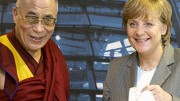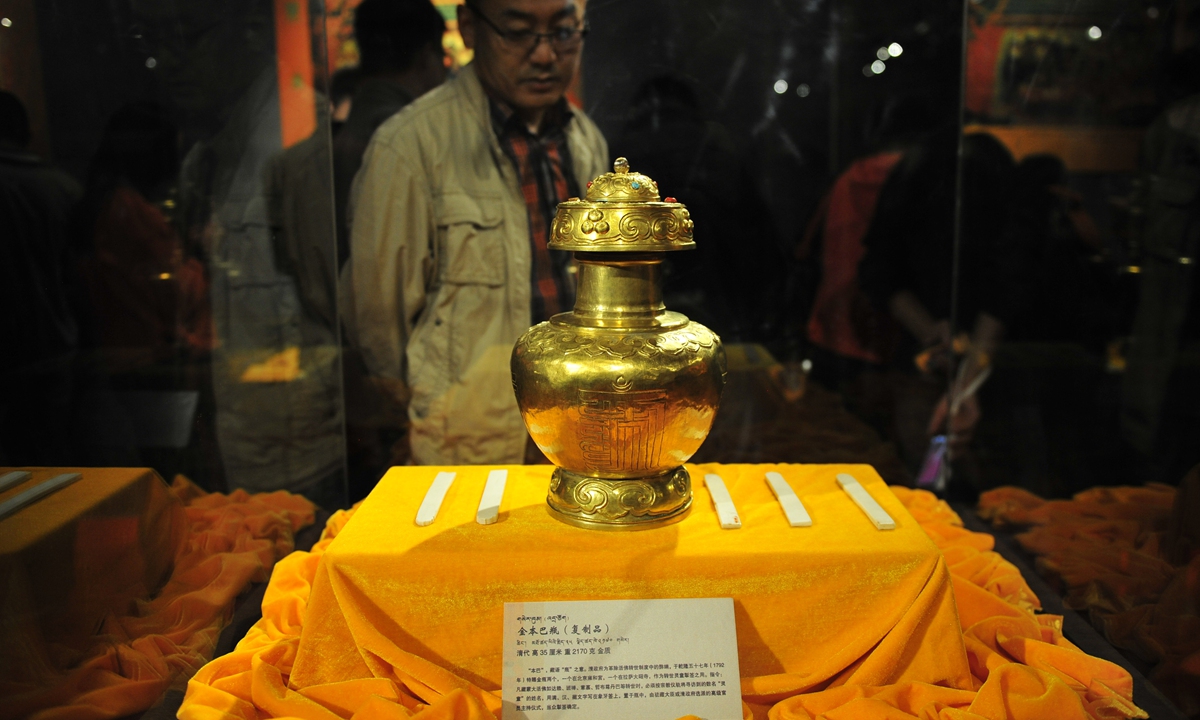Free Tibet? China is preparing for the death of the Dalai Lama
While Xinjiang and Uyghurs dominated the suppressed minority headlines, there hasn’t been anything about Tibet in the Global Times for a long time and nothing about Tibet and the Dalai Lama in the Western media. After the Dalai Lama was still welcomed by western politicians from the 90s to the 2010s, the pressure from Beijing and the prospect of the Chinese supermarket meant that he was no longer welcomed in western metropolises and after he also resigned from his political posts and a introduced a separation between politics and religion in the exile community, interest in this more symbolic, personal cult, and esoteric event dwindled. Headlines like this disappeared:
“Witch Angela” – the Chinese insult Merkel

May 19, 2010 7:54 p.m Dalai Lama reception: She met him in 2005 – and she wants to meet him again, even if China doesn’t like it: Angela Merkel and the Dalai Lama. She met him in 2005 – and she wants to meet him again, even if China doesn’t like it: Angela Merkel and the Dalai Lama In the run-up to the meeting between the chancellor and the Dalai Lama, Chinese Internet users can again attack Angela Merkel personally in online forums – for example as a “witch” – without the state censor immediately removing the attack. Support for Merkel comes from the government camp and from the opposition.”
Now a report on the reincarnation of the 14th Dalai Lama in the Global Times. Will the Dalai Lama die soon and then be replaced by a Chinese candidate? Without localization and sinicization, Tibetan Buddhism has no chance of surviving, according to the Global Times: .
“Chinese central govt’s jurisdiction over Dalai Lama’s reincarnation reaffirmed on intl seminar
By Shan Jie
Published: Oct 03, 2022 08:52 PM

A replica of the golden urn and ivory slips bestowed by the Qianlong Emperor of the Qing Dynasty to the Eighth Dalai Lama is on display at a museum in Lhasa, Tibet Autonomous Region, August 11, 2014. Photo: cnsphoto
Scholars in Tibetology from China and overseas have shared studies and discussed the fixed religious rituals and historical conventions of Living Buddha reincarnation in Tibetan Buddhism through a sideline event of the 51st session of the UN Human Rights Council, during which the jurisdiction of Chinese central government over Dalai Lama’s reincarnation was further reaffirmed.
The event, namely the “International Webinar on the Religious Rituals and Historical Customs of the Reincarnation of Living Buddhas,” was held on Monday from an offline venue at the China Tibetology Research Center in Beijing.
“The affairs related to the reincarnation of the 14th Dalai Lama belong to the domestic affairs of Tibetan Buddhism in China, which must respect the wishes of the Chinese Tibetan Buddhist community and the majority of religious believers, and accept the management of the Chinese government,” Zheng Dui, Senior Fellow and Director-General at the China Tibetology Research Center (CTRC), said at the event in Beijing on Monday.
“This not only has sufficient historical basis, but also conforms to the provisions of the current law, which cannot be shaken by any separatist forces,” he pointed out in his keynote speech.
Ten experts and scholars of related studies made speeches during the event, demonstrating the development of Living Buddhas in Tibetan Buddhism, the religious rituals and historical customs of the reincarnation, and the practice of the sinicization of Tibetan Buddhism.
The reincarnation of Living Buddhas is an institution of succession unique to Tibetan Buddhism and is governed by fixed religious rituals and historical conventions. The institution of reincarnation of the Dalai Lama has been in existence for several hundred years, according to China’s Ministry of Foreign Affairs.
The 14th Dalai Lama himself was found and recognized following religious rituals and historical conventions and his succession was approved by the then central government.
Xizang (Tibet)-related affairs have been a tool of the US and other Western countries used to smear China on human rights and other issues. In December 2021, the US named Undersecretary of State Uzra Zeya as “special coordinator for Tibet.” A year before, then US president Donald Trump signed the so-called “Tibetan Policy and Support Act of 2020” – a bill which grossly interfered in China’s internal affairs.
For a period of time, overseas “Xizang independence” forces and Western politicians have hyped up the issue of the reincarnation of the 14th Dalai Lama for political purposes, ignoring the tradition of the Buddhism, and acting as an adverse influence on the religion.
The central government and relevant local governments in China have never relaxed and never given up their management of the reincarnation of the Living Buddha. The Chinese central government of today adheres to the historical conventions of the reincarnation of Living Buddhas, managing the social and public affairs of the reincarnation of Living Buddhas, while overseeing institutionalized and regulated processes based on relevant laws, Zheng stressed.
Xiao Jie, deputy director at the Institute of Contemporary Studies of CTRC, noted that the reincarnation of living Buddhas has been practiced in China for hundreds of years. It has long been known as religious rituals and historical conventions, and has been confirmed by Chinese laws and regulations.
He believed that some countries’ proposing that “Tibetan Buddhism has become a world religion” and regard the Chinese government’s management of the reincarnation of Living Buddhas as “undermining the freedom of religious belief,” is a great distortion of the reincarnation of Tibetan Buddhist living Buddhas.
“The main believers of Tibetan Buddhism are in China, and in the familiar environment of this group of people, it is undoubtedly reasonable to search for and identify the reincarnated living Buddha in the way they are used to, which also reflects the Chinese government’s ‘people-oriented’ concept,” Xiao said.
The management of the reincarnation affairs of the Living Buddhas, including the Dalai Lama and the Panchen Lama, is a social responsibility that the Chinese central government must perform throughout the course of history, Wang Yanzhong, director at the institute of Ethnology and Anthropology under the Chinese Academy of Social Sciences noted.
“The issue of the Dalai Lama’s reincarnation has never been a purely religious issue, nor the personal power of the Dalai Lamas in the past, but a major political issue involving the ownership of sovereignty,” Fang Sanping, a scholar from the Sichuan Tibetology Institute, pointed out at the webinar.
“After hundreds of years of development and evolution, the Dalai Lama’s reincarnation system has formed a complete set of religious rituals and historical conventions, the core of which is that the central government is the highest authority and has the highest decision-making power,” Fang said.
Jewon Koondhor, a Member of the CPPCC National Committee and Vice President of Xizang Branch of Buddhist Association of China, detailed at the event that after more than 1,300 years of development, Tibetan Buddhism has completed integration with the local natural geographical environment, humanities and folk culture with characteristics and background of Chinese culture.
“This historical process has fully proved that the localization and sinicization of Tibetan Buddhism is an inevitable requirement for the survival and development of the religion itself,” said Jewon Koondhor, a returned Tibetan from Switzerland and is also serving as the Vice Chairman of the Xizang Autonomous Region of the Overseas Chinese.
Sarbottam Shrestha, First Vice President of Arniko Society in Nepal, said at the event that the reincarnation system of Living Buddhas is one of the iconic characters of the sinicization of Tibetan Buddhism. He said that religions adapting to socialist society is an important component of the sinicization of Buddhism and other religions in China.
At the webinar, Birgit Kellner, director of the Institute for the Cultural and Intellectual History of Asia at the Austrian Academy of Sciences, shared the achievements in cooperation between Chinese and Austrian experts in protecting Sanskrit texts from Southwest China’s Xizang Autonomous Region.
She noted that Xizang’s Sanskrit texts hold rich historic and cultural value, and protecting and studying on them has become a part of Chinese government policy. She hopes to maintain close communication with Chinese colleagues and further promote academic research of Sanskrit.
https://www.globaltimes.cn/page/202210/1276546.shtml
China expert and sinology professor Van Ess commented on the article as follows:
„Yes, interesting that this is coming up now. The Dalai Lama once indicated that he might not have a reincarnation at all – because of course he’s worried that he won’t be able to control it from Dharamsala. The next Dalai Lama will be found in Tibet, and that is not where his power extends. He’s 87, so you can ask how that’s regulated. The traditional procedure since the 18th century has been the golden urn from which a lot is drawn that decides the right candidate from a group. The Dalai Lama will not be able to select this group.
The position of the Dalai Lama was invented by the Mongols in the 16th century when they wanted to expand their power into Tibet. The third Dalai Lama was actually the first, so the line was then extended by two leaders. The fourth Dalai Lama was then a Mongol who was grandson of the ruling Altan Khan. This is how the Mongols secured their power over Tibet back then. Only then did the position migrate back to Tibetan families. There are, of course, many Tibetans in Yunnan, Sichuan, Qinghai and Gansu who are related to Chinese by marriage. In the end, however, it will probably be a real Tibetan who will be given a decent education, as was the case with the Panchen Lama.
Interesting that Birgit Kellner from Vienna is quoted. Lhasa has preserved many important texts in Sanskrit that do not exist elsewhere. Many people are interested in researching it, and that is why you need good relations with the authorities in Tibet.”
The fact that the Dalai Lama questioned the doctrine of reincarnation and also described the office of Dalai Lama as unnecessary and „historically young“ caused concern among the traditional Tibetan clergy. Because it would amount to a secularization and democratization of Tibetan Buddhism. Ideal for Beijing to pose as the preserver and guardian of Tibetan Buddhism, dividing Tibetans into exile and mainland communities, within the clergy, and into traditionalists and secularizers. The question is also to what extent the Tibetan youth is still religious at all and could come to terms with a Chinese Dalai Lama. Whether the Tibetans would also agree to a localization and sinification of Tibetan Buddhism, i.e. a Dalai Lama inthornize by Beijing, because that would be better than no Dalai Lama at all or whether they reject him as a colonialist puppet or whether they are at odds over this very issue. .Or whether the nationalist-secular Rangzen alliance is now taking over the leadership of the Tibetan resistance. Yes, whether in desperation they would also resume the armed struggle as in the 1950s, which of course would play into Beijing’s hands, although the question would also be whether the USA and/or India would have any interest to support usch a movement financially and in terms of arms at all -except in the case of a Sino-American war. In any case, the „Free Tibet“ activists are facing very hard times after the coming death of the Dalai Lama. His peaceful policy of „meaningful autonomy“, hope for the international world community and calls for boycotts have failed completely.
Reading recommendations:
Jasminrevolution in Tibet? Der Dalai Lama tritt zurück
Tibetans and Uyghurs: “Independence, Autonomy or Death?
Der Dalai Lama — ein sehr weltlicher Mensch
Neubewertung der Tibetfrage im Wasserresourcenkonflikt?
US Landpower and an Indo-American Alliance